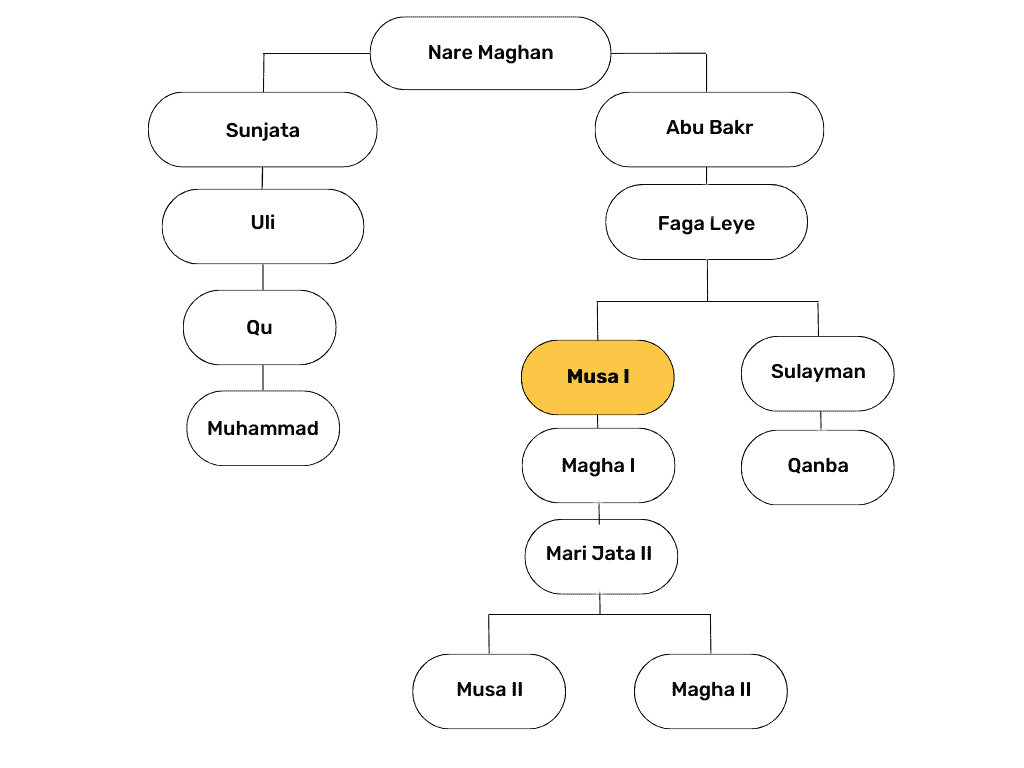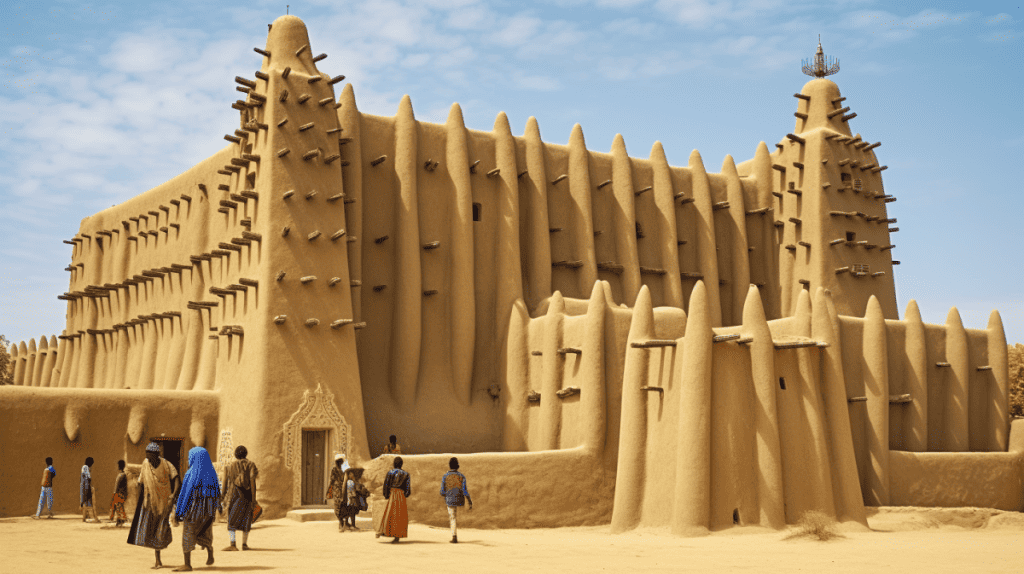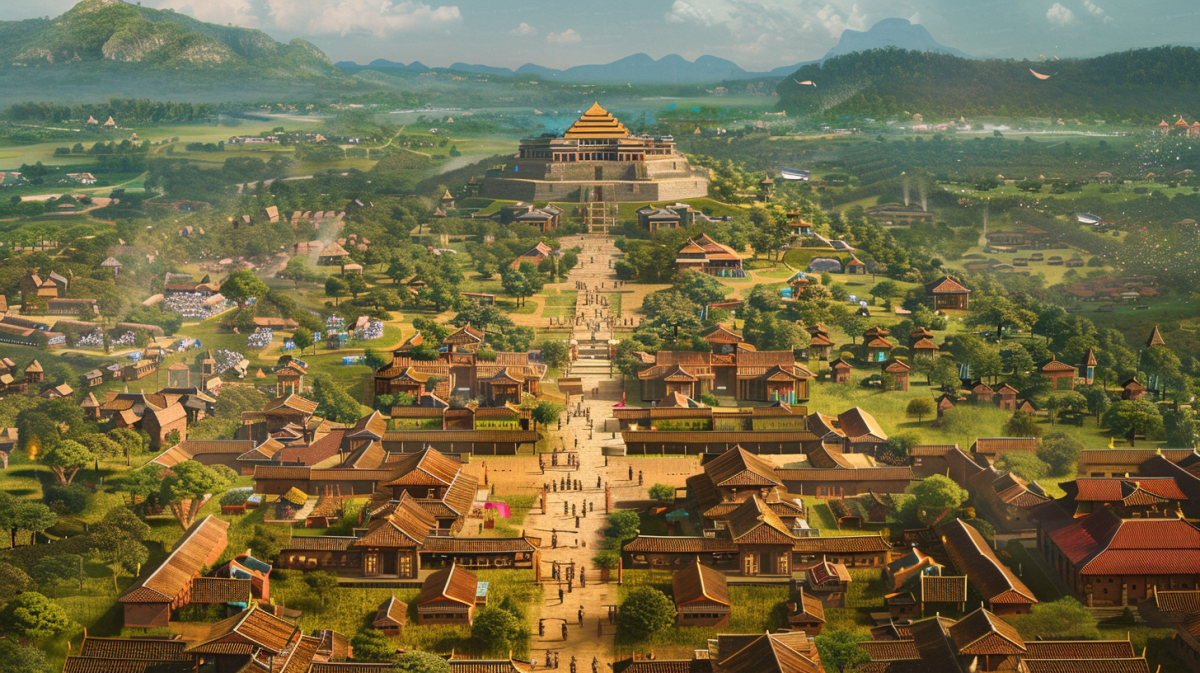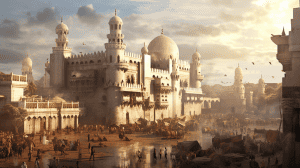Mansa Musa (1312-1337) ruled the Mali Empire and is often dubbed history’s richest person. His pilgrimage to Mecca in 1324 showcased Mali’s immense wealth, influencing trade and culture across the Mediterranean. He championed Islamic scholarship and built the legendary University of Timbuktu.
In the intimate circles of his Arabic-speaking world, Mansa Musa was fondly called Mūsā, while the Mandé referred to him as ‘Mansa’, their term for a sovereign or king. In their legendary oral narratives and the prestigious Timbuktu Chronicles, he was affectionately known as Kanku Musa. As was the custom in Mandé society, an individual’s name was often embellished with their mother’s name. Thus, ‘Kanku Musa’ translates to ‘Musa, the son of Kanku’, yet the true lineage implied remains shrouded in mystery. Within the warm oral tradition, he also bore the title of Hidji Mansa Musa, in reverence to his holy pilgrimage.

Eminent historians like Al-Yafii and Ibn Hajar referred to him as Musa ibn Abi Bakr ibn Abi al-Aswad and Musa ibn Abi Bakr Salim al-Takruri, respectively. In the Songhai language, this valiant ruler was addressed as the Mali-koi, ‘koi’ being an honourable title symbolizing authority over a domain, effectively making him the ‘lord of Mali’.
Upon Mansa Musa’s rise to the throne, Mali absorbed the vast territories of the former Ghana Empire. His empire comprised regions presently known as Guinea, Senegal, Mauritania, The Gambia, and modern Mali.

In 1324, Mansa Musa embarked on a sacred journey to Mecca, the Hajj, surrounded by an extravagant entourage and accompanied by a colossal amount of gold. His journey included a majestic sojourn in Cairo, where his generosity in gifting gold was so magnificent that it allegedly influenced Egypt’s economy and captivated the Muslim world.
Mansa Musa championed the expansion of the Mali Empire, proudly annexing the vibrant cities of Gao and Timbuktu. His heart yearned for a stronger bond with the Muslim community, particularly the Mamluk and Marinid Sultanates. With an eye on fostering intellectual growth, he invited renowned scholars like the Andalusian poet Abu Ishaq al-Sahili from across the Muslim world to his kingdom, thereby transforming Timbuktu into a beacon of Islamic learning. His reign saw the rise of architectural marvels, including the iconic Djinguereber Mosque in Timbuktu. Thus, Mansa Musa’s reign stands out as a radiant pinnacle of Mali’s power and grandeur.
Sources for the Story of Mansa Musa
Our understanding of Mansa Musa primarily springs from Arabic chronicles penned following his celebrated Hajj, notably the accounts of Al-Umari and Ibn Khaldun. During his spiritual sojourn in Cairo, Musa formed close bonds with dignitaries such as Ibn Amir Hajib. The latter gleaned invaluable insights about Musa and his realm, which he later bequeathed to historians like Al-Umari.

Precious snippets about Musa’s life also echo from two revered 17th-century manuscripts penned in Timbuktu – the Tarikh Ibn al-Mukhtar and the Tarikh al-Sudan. The jeliw or griots, custodians of the oral tradition, offer comparatively sparse details about Musa in contrast to other facets of Mali’s rich historical tapestry.
Family Tree
Musa’s lineage traces back to his father, Faga Leye, while his mother is believed to have been Kanku. Faga Leye was the progeny of Abu Bakr, a sibling of the founding monarch, Sunjata, of the Mali Empire. Traveller and historian Ibn Battuta, during his visit to Mali under the reign of Musa’s brother Sulayman, suggested that Musa’s grandfather was Sariq Jata, possibly another moniker for Sunjata, who was indeed Musa’s great-uncle. The exact date of Musa’s birth remains cloaked in mystery, yet he was presumed to be still in his youth in 1324. The renowned manuscript, the Tarikh al-fattash, proposes that Musa inadvertently caused the death of Kanku before embarking on his hajj.

Accession to the Throne & Early Reign
Musa’s ascension to the throne in the early 14th century is shrouded in ambiguity. As per Musa’s narrative, his predecessor, likely Muhammad ibn Qu, had led two daring voyages to explore the uncharted waters of the Atlantic Ocean. Upon venturing into the second expedition himself, the Mansa entrusted the realm’s governance to Musa until his return. When he did not reappear, Musa was anointed as the new Mansa, signifying a shift in the succession from Sunjata’s lineage to that of his brother, Abu Bakr. Contemporary historians have scrutinized Musa’s account, suspecting he might have usurped the throne and fabricated the tale about the journey to rationalize his rise to power. However, several historians have seriously considered the feasibility of such explorations.

The Tarikh al-Fattash reveals that Musa was wedded to Inari Konte. Intriguingly, her clan name, Konte, was shared by Sunjata’s mother Sogolon Konte and his formidable adversary, Sumanguru Konte.
Musa was just on the cusp of adulthood, perhaps in his early twenties, when he was thrust into the role of Mansa. Given the spectacular scale of his ensuing hajj, it can be inferred that much of his initial reign was consumed by rigorous preparation for this momentous journey. A significant part of these preparations would likely have involved launching strategic raids to enslave inhabitants from adjoining territories. His caravan for the hajj would comprise thousands of enslaved individuals. Historian Michael Gomez conjectures that for this purpose, Mali could have captured upwards of 6,000 individuals annually.
Perhaps as a result of these actions, the early years of Musa’s rule were steeped in incessant military confrontations with neighbouring non-Muslim societies. In 1324, during his stay in Cairo, Musa boldly declared that he had successfully annexed 24 cities along with their peripheral districts.
Mecca Pilgrimage
Devoutly committed to Islam, Musa’s grand pilgrimage, the hajj, to the holy city of Mecca thrust him into the spotlight across Northern Africa and the Middle East. For Musa, his Islamic faith served as a portal into the sophisticated milieu of the Eastern Mediterranean. He invested considerable energy in nurturing the religion’s development within his empire.
On the brink of his departure for the hajj, Musa handed over the reins of the empire to his son, Muhammad. His hajj, an epic journey spanning 2,700 miles, unfolded between 1324 and 1325. The awe-inspiring procession reportedly consisted of 60,000 men, clad in brocade and Persian silk, inclusive of 12,000 slaves. Each of these individuals bore 1.8 kg of gold bars. Heralds draped in silk and brandishing golden staffs handled the horses and the bags. Musa meticulously catered to the necessities of his enormous entourage, ensuring the sustenance of both men and beasts. Among these beasts were 80 camels, each loaded with 23–136 kg of gold dust. Musa generously distributed gold to the impoverished he encountered along his path.

Upon reaching Cairo’s outskirts in July 1324, Musa and his entourage made their grand entrance, having camped for three days near the Giza Pyramids. While in Cairo, he engaged with the Mamluk Sultan al-Nasir Muhammad, despite some initial tension. Musa’s stay was characterized by generosity and lavish spending. He continued this benevolence on his onward journey to Mecca, dispensing gifts to pilgrims and locals alike.
In Mecca, Musa intervened to prevent an escalating conflict between Malian and Turkic pilgrims. However, the return journey from Mecca proved disastrous, marked by death and loss from the harsh elements and bandit raids. Strapped for cash, Musa found himself indebted to several merchants, necessitating the reselling of many of his possessions. Nevertheless, al-Nasir Muhammad reciprocated Musa’s generosity with his own show of magnanimity.
On his return voyage, Musa encountered the Andalusian poet Abu Ishaq al-Sahili. Impressed by the poet’s eloquence and juristic knowledge, Musa persuaded him to accompany him back to Mali. Several other scholars, including Maliki jurists, joined Musa’s retinue back to Mali.
During his homeward journey, according to the Tarikh al-Sudan, the cities of Gao and Timbuktu pledged their allegiance to Musa’s rule. This period marked a renewed assertion of Mali’s control over these regions, reinforcing their submission to Musa’s rule.
Later Reign
Construction in the Mali Empire
Embracing a vision of grand architectural design, Musa undertook a substantial construction initiative, gracing Timbuktu and Gao with grand mosques and madrasas. Among his crowning achievements was the historic Sankore Madrasah, a beacon of knowledge erected during his reign. Drawing architectural talent from the Middle East and throughout Africa, Mansa Musa transformed the kingdom of Mali into an intellectual and cultural hub within the Islamic world.

In Niani, the impressive Hall of Audience was birthed under Musa’s auspices. This splendid edifice, internally linked to the royal palace, was a testament to architectural grandeur. Its dome sat high, adorned with arabesques of vibrant hues. The upper storey’s window frames, sheathed in silver foil, contrasted strikingly with the lower storey’s gold-plated versions. Echoing the architectural splendor of the contemporaneous Great Mosque in Timbuktu, the Hall was carved from stone.
Mali experienced a surge in urban sophistication during this era. Sergio Domian, an Italian scholar known for his studies of art and architecture, emphasized the foundation of an urban civilization during this period. At its zenith, Mali boasted a minimum of 400 cities, with the interior of the Niger Delta teeming with inhabitants.
Under Mansa Musa’s leadership, cities like Timbuktu and Gao evolved into significant cultural hubs. Collaborating with architects from the Middle East and across Africa, Musa sculpted the urban landscapes of his kingdom, positioning Mali as a refined seat of learning within the Islamic world.
Economy & Education
Inheriting a kingdom of considerable wealth, Mansa Musa further augmented Mali’s prosperity, transforming it into the richest empire in Africa. His fortune was largely derived from extensive salt and gold mines within his domain, along with significant revenue from elephant ivory.
Historical accounts suggest that Musa passed through the cities of Timbuktu and Gao en route to Mecca, annexing them into his empire upon his return around 1325. He commissioned architects from Andalusia, in Spain, and Cairo, to erect his magnificent palace in Timbuktu and construct the revered Djinguereber Mosque, which impressively stands to this day.
Under Musa’s leadership, Timbuktu blossomed into a vibrant hub for trade, culture, and Islam. Markets teemed with merchants from Hausaland, Egypt, and other African kingdoms. Universities sprang up not only in Timbuktu but also in Djenné and Ségou, further propagating Islam through commerce and education, thus positioning Timbuktu as a nexus for Islamic scholarship. Word of the opulent city within the Malian empire spread across the Mediterranean, luring traders from Venice, Granada, and Genoa to incorporate Timbuktu into their trade routes, eager to exchange their manufactured goods for gold.

Under Musa’s patronage, the University of Sankore in Timbuktu was replenished with a host of jurists, astronomers, and mathematicians. This university evolved into an intellectual and cultural hub, attracting Muslim scholars from across Africa and the Middle East to the thriving city of Timbuktu.
Decline of the Empire & Death of Mansa Musa
In the year 1330, the kingdom of Mossi launched a surprise attack and seized the city of Timbuktu. Musa, who had already commanded his general to capture Gao, swiftly took back Timbuktu. Determined to fortify the city against any future threats, he ordered the construction of a stone fort and rampart and stationed a permanent army for its defence. Though Musa’s palace has disappeared with the sands of time, the university and mosque he built remain as enduring symbols of his reign in present-day Timbuktu.

The precise date of Mansa Musa’s death remains shrouded in mystery. Utilizing the lengths of reign reported by Ibn Khaldun and working backwards from Mansa Suleyman’s demise in 1360, it’s inferred that Musa may have passed away in 1332. Nonetheless, Ibn Khaldun also records that Musa sent a message of congratulation to Abu al-Hasan Ali on his conquest of Tlemcen, which occurred in May 1337. But by the time Abu al-Hasan reciprocated the gesture, Musa was no more and Suleyman had ascended to the throne, hinting at Musa’s demise around 1337. Yet, in an intriguing twist, al-Umari, penning down his accounts approximately twelve years after Musa’s pilgrimage, around 1337, asserted that Musa intended to abdicate and retire to Mecca but death claimed him before he could realize this wish, implying he may have passed even before 1332.
It could be the case that Musa’s son, Maghan, was the one who exchanged pleasantries with Abu al-Hasan or received Abu al-Hasan’s envoy following Musa’s death. This notion finds support in Ibn Khaldun referring to Suleyman as Musa’s son in that context, hinting at a possible confusion between Musa’s brother Suleyman and his son Maghan. Alternatively, the four-year reign attributed to Maghan by Ibn Khaldun might actually refer to the period when he ruled Mali during Musa’s pilgrimage, with his independent reign being relatively brief. Nehemia Levtzion endorsed 1337 as the probable year of Musa’s death, a belief that has been embraced by other scholars.
Legacy of Mansa Musa
Musa’s era is often lauded as the golden epoch of Mali, a viewpoint potentially arising from the abundance of records in Arabic describing his reign, rather than an objective reflection of him as the wealthiest and most influential mansa. Under Musa and his brother Sulayman’s reigns, the Mali Empire reached its territorial zenith, dominating the Sudan-Sahel region of West Africa.
In the Mandé oral tradition performed by the jeliw, Musa’s fame is somewhat diminished. He is often chastised for betraying tradition, with some jeliw viewing him as a squanderer of Mali’s wealth. Yet, certain aspects of Musa’s life seem to have been embodied in a character from Mandé oral tradition known as Fajigi, the “father of hope”. Fajigi is commemorated as a traveller to Mecca who brought back ceremonial objects known as boliw, significant in Mandé’s traditional religion. Fajigi’s character often merges with that of Fakoli, a notable general under Sunjata, thereby combining elements of both Islam and traditional beliefs.
The name “Musa” has become virtually interchangeable with the concept of a pilgrimage in Mandé lore, such that other pilgrim figures, like Fakoli, are also referred to as Musa.
Mansa Musa is celebrated for his immense wealth and generosity. Digital articles in the 21st century have even proclaimed him as the richest person in history. These claims primarily originate from an article by CelebrityNetWorth, which pegs Musa’s fortune at an equivalent of US$400 billion. Yet, CelebrityNetWorth has been challenged for its inconsistent estimates. Historians like Hadrien Collet argue that assessing Musa’s actual wealth is an impossible task. Arabic sources from Musa’s era might have tried to convey an incomprehensible scale of wealth rather than presenting an exact figure. Moreover, accurately comparing the affluence of historical figures like Mansa Musa is a challenge due to the complex task of distinguishing a monarch’s personal wealth from the state’s and the difficulty in comparing wealth across disparate societies. Musa’s hajj might have included up to 18 tons of gold, equivalent to over US$957 million in 2022 value. Further enhancing the illusion of limitless wealth, Musa himself propagated tales that gold grew naturally in his kingdom.
According to certain Arabic scribes, Musa’s excessive gift-giving resulted in a decline in Egypt’s gold value. Al-Umari recounted that prior to Musa’s visit, a mithqal of gold was valued at 25 silver dirhams, but it fell to less than 22 dirhams afterwards, a rate which persisted for at least a dozen years. While this has been portrayed as having “wrecked” Egypt’s economy, historian Warren Schultz argues this was within the normal range of gold value fluctuations in Mamluk Egypt.
The Mali Empire’s prosperity didn’t stem from direct control over gold mines, but rather from trade and tributes. The gold Musa brought on his pilgrimage likely represented years of accumulated tribute, which he would have spent a significant portion of his initial reign amassing. During Musa’s reign, another key source of revenue for Mali was the taxation of copper trade.
Related Posts
Sources
“National Geographic Society. “Mansa Musa, Musa I of Mali.” National Geographic Resource Library. Accessed June 20, 2023. https://education.nationalgeographic.org/resource/mansa-musa-musa-i-mali/.“
“Wikipedia contributors. “Mansa Musa.” Wikipedia, The Free Encyclopedia. Last modified June 20, 2023. https://en.wikipedia.org/wiki/Mansa_Musa.”







